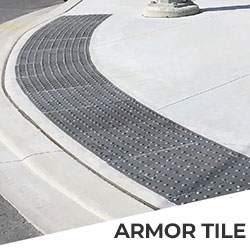









In public spaces across Canada, you may have noticed textured ground surfaces with small, raised bumps installed in areas like curb ramps, transit platforms, and building entrances. These indispensable installations are known as detectable warning surfaces or tactile walking surface indicators (TWSIs).
But what exactly are detectable warning surfaces, and how do they enhance pedestrian safety? This comprehensive guide will explore these tactile tiles' critical role in creating accessible, hazard-free environments for all individuals.
Detectable warning surfaces, commonly called truncated dome tiles or tactile pavers, are textured ground indicators that provide a noticeable underfoot cue detectable by cane or foot. Installed at key locations in the pedestrian environment, they serve two main purposes:
These surfaces feature standardized textures and high color/brightness contrast with surroundings to be easily discernible. As per Canadian accessibility legislation like the Accessibility for Ontarians with Disabilities Act (AODA), integrating detectable warning surfaces in certain public spaces is a legal obligation.
Now let's explore how thoughtfully installed detectable warning tiles can enhance pedestrian safety in impactful ways.
One of the most crucial applications of detectable warning surfaces is that it warns pedestrians about impending dangers or level changes along their path. Key locations where these cues offer vital hazard warnings include:
The distinctive bumpy texture and high visibility of detectable warning surfaces prompt pedestrians to stop, assess the upcoming hazard, and proceed with caution. This is especially helpful for individuals with visual disabilities in avoiding mishaps.
Detectable warning surfaces also integrate anti-slip properties into their design. The textured tile surface, with small raised domes/bars, creates friction that prevents slips and improves traction for pedestrians in all weather conditions.
This slip-resistant texture provides a safe walking surface, especially useful when transitioning between levels or walking on sloped areas like ramps. The wetness-resistant anti-slip surface gives all pedestrians, able and disabled, better footing to deal with Canada's varied climate.
Detectable warning surfaces are designed to be highly noticeable underfoot using color/brightness contrast and texture. This pronounced sensory difference from the surrounding ground captures pedestrians' attention and prompts them to mindfully assess their environment before proceeding.
The eye-catching surface causes even distracted walkers to look up from their phones and take in important cues like changes in elevation or vehicular traffic before moving forward. This heightened environmental awareness helps pedestrians avoid accidents.
Detectable warning surfaces don't just warn about hazards – they also actively guide pedestrians along safe walking routes when installed as wayfinding paths.
Detectable warning surfaces with parallel elongated bars help outline safe passageways through large open public spaces where navigation is challenging. The linear bars point the way forward, allowing pedestrians with vision disabilities to traverse unfamiliar environments confidently by following the tactile directional cues.
As per provincial laws like the Accessibility for Ontarians with Disabilities Act (AODA) and the Ontario Building Code (OBC), integrating detectable warning surfaces in public spaces is not just an ethical obligation - regulations mandate it.
Installing compliant detectable warning tiles protects business owners and contractors from lawsuits and fines for failing to provide accessible infrastructure as per codes. It also ensures that public spaces are designed inclusively to accommodate all users.
As Canada's premier accessibility solutions provider, Tactile Solutions offers a wide selection of detectable warning tiles engineered to enhance pedestrian safety. Some of our top products include:
Common materials for detectable warning surfaces are concrete, durable polymers, porcelain, rubber, metals, stainless steel, and engineered composites. The material is chosen based on the location.
Key locations are transit platforms, curb ramps, pedestrian crossings, building entrances, stairs, escalators, information kiosks, service counters, and parking areas.
They warn about upcoming hazards, provide slip resistance, draw attention to surroundings, guide users along paths, and ensure code compliance.
High-quality detectable warning tiles can last 25+ years with minimal replacement needs beyond occasional damaged tile replacement.
By investing in compliant detectable warning surfaces from Tactile Solution Canada, builders, contractors, and property owners in Canada can make public environments seamlessly accessible to all while fulfilling safety obligations.
